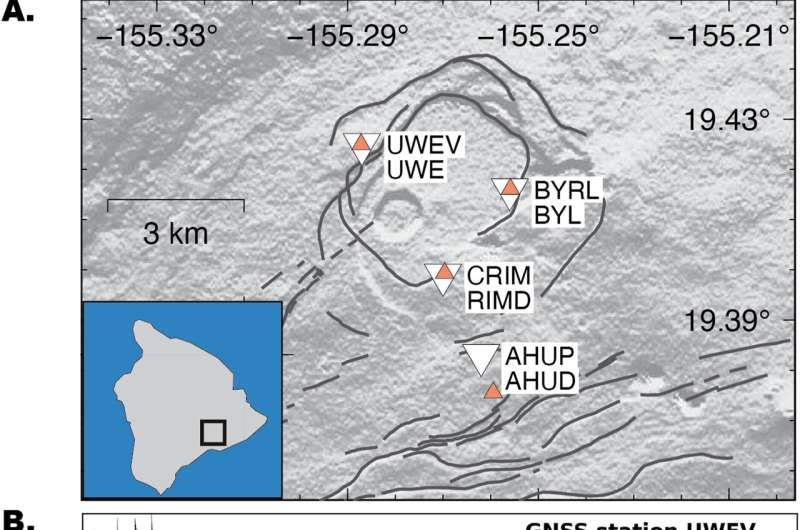
A team at Los Alamos National Laboratory has used machine learning—an application of artificial intelligence—to detect the hidden signals that precede an earthquake. The findings at the Kīlauea volcano in Hawaii are part of a years-long research effort pioneered at Los Alamos, and this latest study represents the first time scientists were able to detect these warning signals in a stick-slip fault, the kind that can generate massive destruction.
The paper is published in the journal Geophysical Research Letters.
“We wanted to see if we could pull out signals from the noise and identify where in the loading cycle the system was in terms of nearing a major slip, which causes earthquakes,” said Christopher Johnson, a seismologist at Los Alamos and the team’s lead researcher. “This is the first time we’ve been able to apply this method to an earthquake of this type and of this magnitude.”
The team used data recorded between June 1, 2018, and August 2, 2018, by the U.S. Geological Survey’s Hawaiian Volcano Observatory. In this time, the volcano experienced more than 50 quakes of varying magnitudes. Researchers focused on 30-second windows of seismic data, and their model identified something akin to a fingerprint, a hidden signal, that tracked the loading cycle of each event. On average, that hidden signal appeared continuous prior to a detectable large ground movement.
Combined with previous tests, the results suggest that some earthquake faults share similar physics, meaning this method could be used to assess earthquake hazards across the globe.
Patterns in the noise
The research builds on previous work conducted by Los Alamos on faults in California and the Pacific Northwest, where machine learning was able to detect these precursory signals.
As tectonic plates press against each other, they create weak tremors in the ground, called continuous acoustic or seismic emissions. These signals appear like waveforms when recorded but were previously believed to be noise—data without information describing the state of the fault. Instead, Los Alamos researchers have found that continuous acoustic emission waveforms are, in fact, rich with data and can be used to infer physical properties of a fault, such as displacement, friction, and thickness.
Most importantly, Los Alamos scientists have found highly predictable patterns in the signals, a sort of timeline to failure.
“When we look at these continuous signals, we can pull out information that tells us where the fault is in its loading cycle,” Johnson said. “We’re looking at how the noise evolves and that gives us details about its current state and where it is in the slip cycle.”
From slow-slip to stick-slip
The team’s research was the first time they successfully applied the approach to seismogenic faults, the layer in which earthquakes originate. In this case, that was a sequence of highly active, magnitude-5 stick-slip events at the Kīlauea volcano, which experienced a months-long seismic event that led the caldera to sink 1,600 feet.
During that time, a global navigation satellite system measured millimeter-scale displacement of the ground. The machine learning model then analyzed this data, processed the seismic signals, and successfully estimated the ground displacement and time to the next fault failure.
Previously, Los Alamos researchers had applied similar machine learning models to slow-slip events, which cause the ground to rattle subtly for days, months, or even years before a seismic event. Such large data sets were helpful to train the machine learning models. But the most destructive earthquakes are caused by stick-slip faults, like that found at the Kīlauea volcano, which can generate much stronger ground motions more quickly, and have until now eluded prediction.
More information:
Christopher W. Johnson et al, Seismic Features Predict Ground Motions During Repeating Caldera Collapse Sequence, Geophysical Research Letters (2024). DOI: 10.1029/2024GL108288
Citation:
Modeling software reveals patterns in continuous seismic waveforms during series of stick-slip, magnitude-5 earthquakes (2024, June 25)
retrieved 25 June 2024
from https://phys.org/news/2024-06-software-reveals-patterns-seismic-waveforms.html
This document is subject to copyright. Apart from any fair dealing for the purpose of private study or research, no
part may be reproduced without the written permission. The content is provided for information purposes only.







